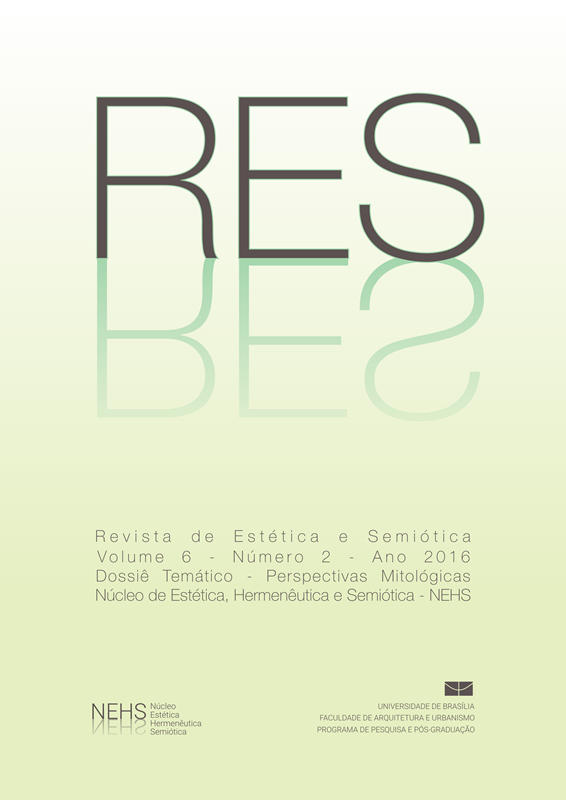THE MYTHIC EXEMPLUM IN ARGONAUTICA: literary selfconsciousness in the epic by Apollonius of Rhodes
DOI:
https://doi.org/10.18830/issn2238-362X.v6.n2.2016.05Keywords:
Argonautica, Epic, Exemplum, MythAbstract
In the epic poem Argonautica by Apollonius of Rhodes, the myth of Theseus and Ariadne is used by the main hero as an exemplum, because of its similarity to that of Jason and Medea, the main story of this work. In
this paper, we present an analysis on the function of this exemplum in the narrative technique of Argonautica as well as their metapoetic meanings. According to our reading, the combination of the technique of the exemplum ”“ an outstanding trait of epic genre already in the homeric poems ”“ and ellipsis of the tragic end of the story of Ariadne (and hence the allusion to the tragic end of Medea) creates a particularly literary effect, which brings into play in the narrative plot of the play a tension between the literary tradition and this poem. In this tension, literary self-consciousness of the work is expressed.
Downloads
References
CALAME, Claude (1991). “‘Mythe’ et ‘rite’ en Grèce: Des catégories indigènes?”. Kernos [En ligne], vol. 4. URL : http://kernos.revues.org/299.
DÄLLENBACH, Lucien (1989). The Mirror in the Text. Cambridge, University of Chicago Press.
DETIENNE, Marcel (1981). L’Invention de la mythologie. Gallimard, París.
EDMUNDS, Lowell (1997). “Myth in Homer”, en: POWELL, Barry & MORRIS, Ian (eds.), A New Companion to Homer. Brill, Leiden-New York- Köln, pp. 415-441.
FRÄNKEL, Hermann (1961). Apollonii Rhodii Argonautica. Oxford University Press: Oxford.
HUNTER, Richard (1988). “Short on Heroics”, Classical Quarterly, Cambridge, vol. 38, pp. 436-453.
_______ (1989). Apollonius of Rhodes: Argonautica. Book III. Cambridge University Press, Cambridge.
_______ (1993) The Argonautica of Apollonius: Literary Studies. Cambridge University Press, Cambridge. LANG, Mabel (1983). “Reverberation and Mythology in the Iliad”, en: RUBINO, Carl & SHELMERDINE, Cynthia (eds.) Approaches to Homer. University of
Texas Press, Austin.
LOWENSTAM, Steven (1992). “The Use of Vase- Depictions in Homeric Studies”, Transactions of the American Philological Association, Johns Hopkins University Press, vol. 122, pp. 165-98.
MARTIN, Richard (1989). The Language of Heroes. Speech and Performance in the Iliad. Cornell University Press. Ithaca, New york.
MORFORD, Mark & LENARDON, Robert (2003). Classical Mythology. 7ma ed. Oxford University Press, Oxford.
NAGY, Gregory (1996). Homeric Questions. University of Texas Press, Texas.
ROSE, Herbert Jennings (1958). A Handbook of Greek Mythology: Including Its Extension to Rome. 6ta. ed. Methuen, Londres.
VALVERDE SÁNCHEZ, Mariano (1989). El aition en las Argonáuticas de Apolonio de Rodas: estudio literario. Murcia, 324 pp., Tesis Doctoral, Area: Letras. Universidad de Murcia.
VIAN, Francis (1955). Apollonios de Rhodes. Argonautiques. Tome II. Chant III. Les Belles Lettres, París.
_______ (2000). Apolonio de Rodas: Argonáuticas. Gredos, Madrid.
WEBSTER, Thomas (1966). “The myth of Ariadne from Homer to Catullus”, Greece & Rome, Cambridge, Vol. 13, No. 1, pp. 22-31.
WILLCOCK, Malcolm (1964). “Mythological Paradeigma in the Iliad.” Classical Quarterly, Cambridge, vol. 14, pp. 141”“154.
_______ (1977). “Ad Hoc Invention in the Iliad”, Harvard Studies in Classical Philology, Harvard, vol. 81, pp. 41”“ 53.




